AMD Radeon HD 7750 & Radeon HD 7770 GHz Edition Review: Evading The Price/Performance Curve
by Ryan Smith & Ganesh T S on February 15, 2012 12:01 AM EST- Posted in
- GPUs
- AMD
- HTPC
- GCN
- Radeon HD 7000
Power, Temperature, & Noise
As always, we wrap up our look at a new video card with a look at the physical performance attributes: power consumption, temperatures, and noise.
While it’s the second sub-series of the 7000 series, the 7700 series is actually first in a number of ways for AMD. It’s the first midrange series to feature PowerTune since its introduction in 2010, and it’s the first time the 28nm process has been used on such low power cards. As such the power, temperature, and noise characteristics of the 7700 series are virtually a blank slate waiting to be filled.
| Radeon HD 7700 Series Voltages | ||||
| Ref 7750 Load | Ref 7770 Load | XFX R7770 BESDD | ||
| 1.1v | 1.2v | 1.2v | ||
The idle voltage for all 3 of our 7700 series cards was 0.825v. Meanwhile the load voltage for our 7750 was 1.1v, while it was 1.2v for both the reference 7770 and the XFX BESDD.
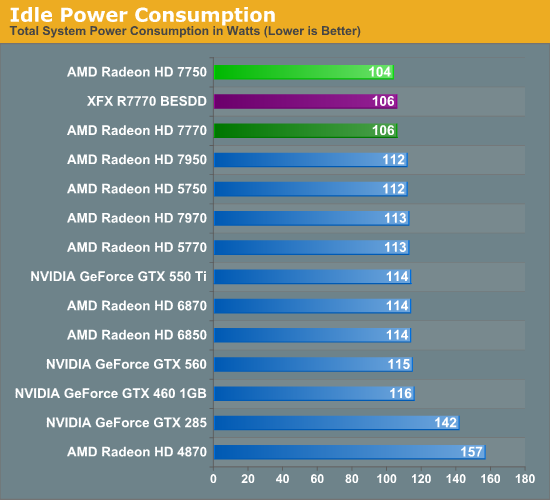
AMD’s official idle power consumption figure is <10W for both the 7750 and 7750. In practice we find that there’s a 2W difference between the two cards, with the 7750 coming in at 104W at the wall and the 7770 at 106W. AMD’s continuing efforts to reduce idle power consumption are clearly paying off, making this the lowest idle power usage figures we’ve recorded yet.
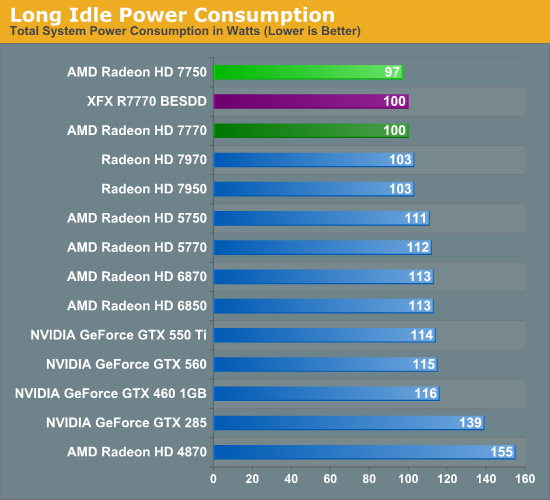
Meanwhile under the so-called “long idle” scenario with a blank monitor, the 7000 series continues to cement its lead. Officially all Southern Islands cards have a long idle power consumption level of <3W since they should all be using the same PCIe controller to keep a heartbeat going, however we’re finding there is a difference, even between the 7750 and 7770. The 7770 consumes 3W less than the 7900 series, meanwhile the 7750W consumes another 3W less, bringing it down to 97W. Since our readings are from the wall it’s tough to gage just how much these cards are still using, but at this point there doesn’t seem to be much farther to drop.
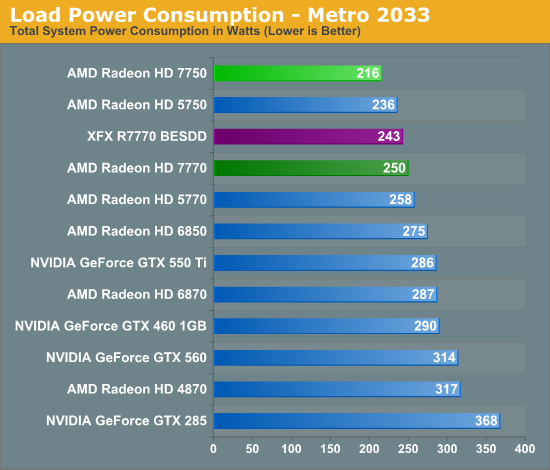
When we talk about the 7700 series bluring the line between what we’d expect out of an AMD 700 series card and an AMD 600 series card, results like this are part of the reason why. With a 75W PowerTune limit the 7750 has the lowest power consumption of any of the cards in our lineup, beating even the 5750. The 7750 is clearly in a league of its own, with only the 7770 drawing similar amounts of power as the 5700 series.
To that extent, it’s interesting to note that the XFX BESDD consumes less power than the reference 7770, in spite of its factory overclock. XFX did not increase the voltage of the card, but we’d still expect power consumption to go up at least a bit, not come down. In any case even with its 10% better performance, it’s consuming 7W less than the reference 7770 here. Otherwise at 250W the 7770 is pulling 8W less than the 5770 and 25W less than the 6850 from the wall, succinctly showcasing the power benefits of TSMC’s 28nm process.
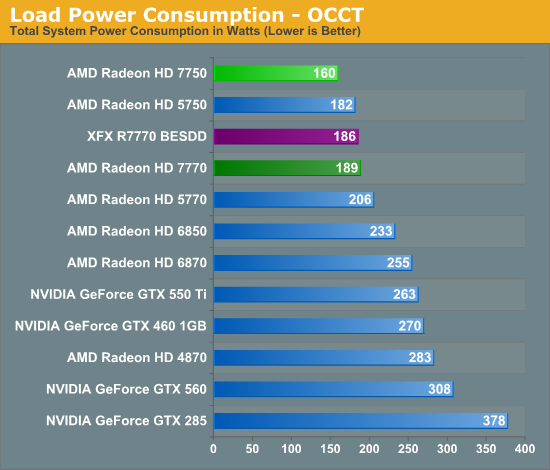
Our results with OCCT largely mirror Metro, with the 7750 in a class of its own while the 7770 consumes less power than anything other than the 5750. Since this is our pathological test, the lack of PowerTune plays a big part here, as PowerTune keeps the 7770 capped at 100W while the 5770 and 6850 are free to go well over their TDPs.
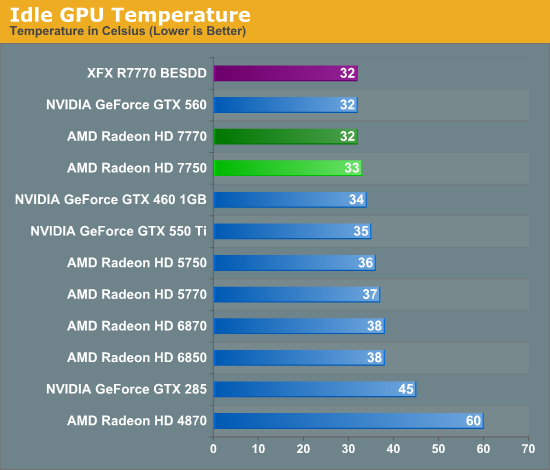
There’s little to say about idle temperatures that hasn’t been said before. With a half-decent cooler, almost any card can reach the mid-to-low 30s. The 7700 series is no exception.
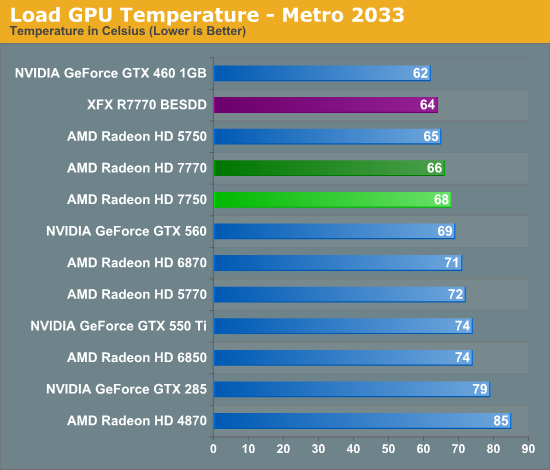
Moving on to Metro, our results are largely consistent with what we’d expect given our earlier power data. Even with the lower power consumption of the 7700 series AMD can’t quite beat the GTX 460 1GB, otherwise with temperatures in the mid to upper 60s the 7700 series looks quite good. XFX’s BESDD looks especially good thanks to the fact that it’s an open air cooler, as it only reaches 64C.

As with OCCT power consumption, OCCT temperatures are largely a story of PowerTune or the lack thereof. With PowerTune clamping down on power consumption, temperatures never rise by too much. At 71C the reference 7770 is still doing well, while XFX’s card does even better.
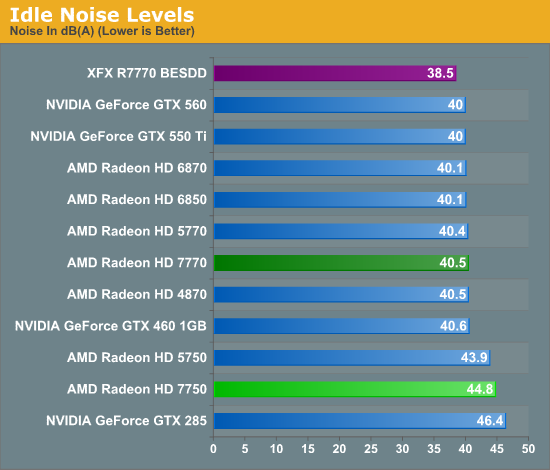
Based on our power and temperature data, our noise data came at somewhat of a disappointment. The 7750 has a small fan with an idle fanspeed of 39%, leading to it being quite loud relative to its competitors. Thankfully none of AMD’s partners will be using that specific cooler, so we wouldn’t expect any retail cards to be this bad. Though if silence is key, Sapphire’s passively cooled 7750 is always an option.
As for our 7770 cards there aren’t any surprises. The open air cooled XFX BESDD does the best, though at only 40.5dB the reference 7770 is doing almost as well on its own.
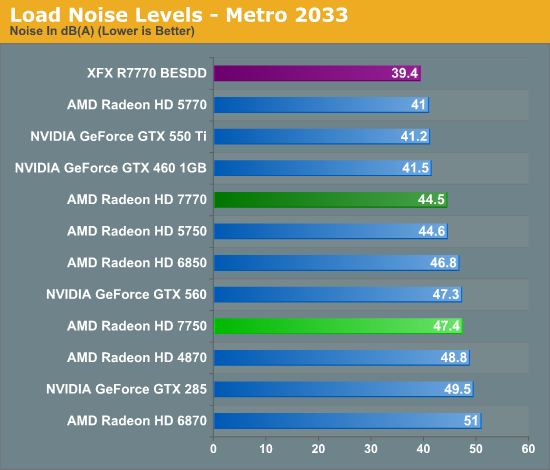
I had to rerun Metro a few times just to make sure our XFX BESDD numbers are right; and they were. XFX’s open air cooler combined with the 100W board limit of the 7770 means that there’s relatively little heat to dissipate, which the open air cooler does extremely well. While this isn’t technically silent it’s damn close.
Elsewhere the reference 7770 does decently, but its half blower nature hurts it when it comes to noise. The noisy 7750 only gets louder, unfortunately.
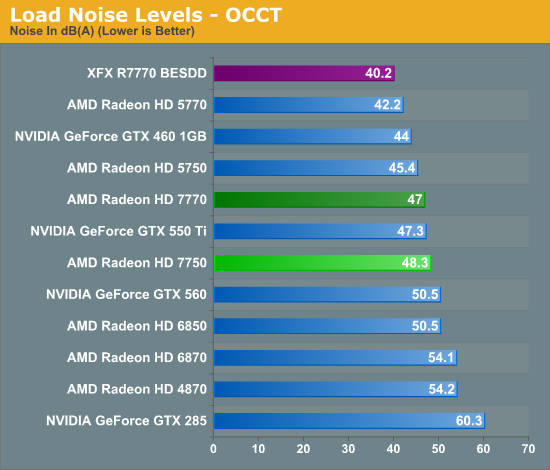
Finally, noise under OCCT is nearly the same story. The XFX BESDD finally goes above 40dB, a testament to the capabilities of XFX’s open air cooler. As for the AMD cards, there’s really not a great deal positive to say as even a traditional blower shouldn’t be quite as bad as what we’re seeing with the reference 7770. Perhaps it’s for the best that none of AMD’s partners are using their reference designs.










155 Comments
View All Comments
KaDomoT - Wednesday, February 15, 2012 - link
Soemthing went very wrong during your Skyrim testing. I ran a 6870 in a similar rig (X4 955 @ 3.5ghz, 4gb ram, no ssd) @ 1920x1080 with 4x AA / 16x AF and A LOT of texture mods and my fps was MUCH higher than that. Not only that, but this was before the big performance boost in patch 1.4 / before I had even heard of SkyBoost!Admittedly my card was overclocked a good chunk (955 core / small mem oc) and my cpu had 600mhz on yours but no way that accounts for some massive 35+ fps difference especially when you guys have the performance patch and no mods.
takeship - Wednesday, February 15, 2012 - link
I think what everyone is missing here is that neither the 7750 or 7700 is really a card for builders, but for the OEM system builders, local shops, etc. For that segment, these cards are fastastic. Just look at the power and thermal loads - if you're HP, now you know you can sell the end customer a 7750 "HD Video" build for cheap, or a push the upgrade to 7770 based "HD Gaming" system without changing the power supply or cooling! That's huge for those guys. Simplification of the assembly line, part variety, etc etc. Same thing with Dad at home. Kid wants to play Battlefield? Buck at the shop around the corner knows that 7770 will get him there and then some playing on their "old" 1080p monitor without worrying that he'll see them back in 4 months when the system melts.CknSalad - Wednesday, February 15, 2012 - link
I think it's best to wait for kepler. There's really no point to be an early adopter of ati's 28nm cards. I'm sure the price will be fixed as the way it should comparable to nvidia's offerings. I just hope that nvidia is really taking the time to actually make quality gpus that are fairly mature. I wonder when there will be stable, legitimate drivers for ATI's 28nm cards. Hopefully that will give a decent boost in performance.haukionkannel - Wednesday, February 15, 2012 - link
Well this seems to be the trend. Older cards allways seems to better in bang for the buck department.It has been very slow time in GPU selling, so there are a lot of those old 5xx and 6xxx cards, so they have to sell those out before they can recure the prices for these new... Or nobody would buy those older allready produced cards. It is pity to us consumers, but a must to GPU manufacturers.
At this moment there is allmot none reason for AMD to make old 6xxx series cheaper, because the Nvidia is not making enough pressure. So they release new cards at extreme prices and sell those old card first.
Nogib - Wednesday, February 15, 2012 - link
I have been looking for an upgrade for my 4850 512MB card with a similar great bang for the buck that this card has given me all these years. Guess I'm still going to be looking. 7770 is close, but not enough of a leap to be honest. And while I'm sure the 78xx series will be great, I'm guessing it will be at a $250-$299 price range which is far beyond what I would ever consider spending on a video card. Sigh.Mathos - Wednesday, February 15, 2012 - link
You're right about the price/performance thing for a release.But, you also have to take some things into consideration. Some of the performance difference is likely due to the 6800 cards having a 256bit memory bus, as opposed to 128bit. Even with that standing I'm amazed the 7770 gets as close as it does. The main reason the 7770 is more expensive, I'm thinking is more likely so they can cease production on the 6800 series and dump inventory. The 68xx cards have been out for a while, and have benefited from many driver optimizations, but, you're not likely to see any more performance out of them from driver updates than what they already have. The 77xx cards are still based on a new core, which through driver updates will likely get much better performance over time.
Bottom line for me though, is, does it perform better than the 5770 that I currently have. Which, it does so considerably. More than could be said for the 6770. It also makes me wonder if they aren't gonna end up doing a 7790, basically a cut down pitcairn with a 256bit bus, like they did with the 6790.
chizow - Wednesday, February 15, 2012 - link
lol Hi rarson. :)Looks like you almost get it. Don't worry once the 7800 parts launch it'll fill in the blanks for you. The entire 7-series product stack pricing fails, top to bottom.
marc1000 - Wednesday, February 15, 2012 - link
actually the 7850 is the real star here. a board that does not require pci-e power and is able to almost match the 5770 in performance on most of the games. that was a 100w card.in the other hand, this makes me a little worried about the power requirements of 7800 series. i am hoping that both 7850 and 7870 will require only 1 pci-e power plug. my case is not big enough to handle more heat than that, and this is why i dont upgrade to a GTX560 (2x power connectors).
mczak - Thursday, February 16, 2012 - link
I think for the 7850 there is a possibility it would only have 1 power connector.The expectation is that Pitcairn is roughly "2xCape Verde", which means it should have roughly twice the power draw too. Twice the 7750 power draw is easily under 150W, whereas twice the 7770 power draw is not (well close actually according to measurements, but clearly these cards want to allow powertune +20% settings and overclocking).
That would be similar to HD6850/HD6870 where the 6850 only has one pcie power connector but the 6870 has two.
marc1000 - Thursday, February 16, 2012 - link
i meant 7750 is the star here.